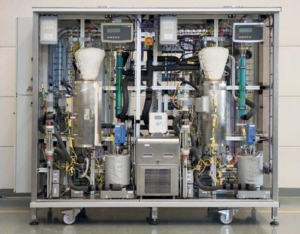Introduction
The Cyclic Deactivation Unit is the method to obtain a resembling equilibrium catalyst (E-cat) at laboratory scale. In order to achieve that, the cyclic nature of commercial fluid catalytic cracking (FCC) is simulated.
When evaluating FCC catalysts at laboratory scale, it is crucial that fresh catalyst is properly deactivated to a so called equilibrium catalyst (E-cat) sample. E-cat is a mixture of fractions with a distribution of age, metals and activity. In effect, some particles are loaded with metals or carbon and have lost most of their surface area. On the other hand, other particles are relatively fresh with extremely high surface area and unit cell size.
So, to obtain a mimic E-cat sample at laboratory scale, both cyclic hydrothermal deactivation and cyclic metal deposition must be simulated in a well-controlled manner. Specifically, this means closely resembling deactivation in a commercial FCC unit.
The activity, metal content, metal oxidation state and textural properties like surface area and micro-pore volume of the deactivated catalyst must be created as close as possible to the commercial E-cat.
Albemarle® pioneered this technology and 360°KAS brought it to market in 2003 in the form of our bench-scale CD Unit.
Cyclic Deactivation Unit – Features
The 360°KAS CD unit is the only method to reproduce all the fundamental phenomena that simulate the aging process in a commercial FCC operation. Based upon the amount of E-cat you require for performance testing, our CD unit is supplied with either one (CD), two (MCD-2) or four (MCD-4) reactors.
Next to the common utilities, each CD reactor comes with the following process modules:
- Gas feed delivery modules for N2/H2, N2/O2, N2/C3H6, N2/SO2 and N2.
- A steam generation module with a de-mineralised water feed.
- Heated liquid oil feed supply module with injection system.
- Reactor module.
- Product treatment module (condenser).
- Closed chilled water cooling system.



